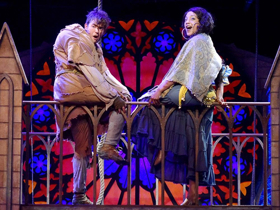Review: THE HUNCHBACK OF NOTRE DAME-A NEW MUSICAL at Solvang Festival Theater

PCPA's production of The Hunchback of Notre Dame - A New Musical, now on stage in Solvang's Festival Theater, delights audiences with its overtly theatrical storytelling style. If you are only familiar with the Disney film based on Victor Hugo's epic novel, this Hunchback includes new music, deeper characterizations, and plot elements to suit the taste of today's theater audiences.
For example, the production's heroine, Esmeralda (Amani Dorn) determines her own fate rather than relying on being rescued by men. Dorn portrays Esmeralda as someone whose attractiveness comes from her sense of moral engagement as much as her lively dancing.
The story lifts us to the heights of Notre Dame Cathedral's bell tower where Quasimodo (Nick Tubbs), the eponymous hunchback, lives a secluded life, concealed for his physical differences by his cruel guardian, Dom Claude Frollo (played with mustache-twirling villainy by Erik Stein sans mustache). Quasimodo dares to defy Frollo and joins the Paris crowds on the Feast of Fools. There, he meets the gypsy Esmeralda, who first encourages him to become the King of the Fools; why not take advantage of his day? She then shields him from the violence of the Paris mob as they throw rocks and abuse at Quasimodo for his jarring appearance.
For this act of kindness, Quasimodo falls in love with Esmeralda. Unfortunately, Frollo simultaneously falls in lust with her--something his role as leader of the Church will not accommodate. Meanwhile, an army captain, Phoebus (played on opening night with understudy Sam Lariviere without a hitch) also becomes smitten by the gypsy dancer. Complications ensue.
Scenic designer Jason Bolen has crafted a multi-level set opening up the interior of Notre Dame with its stained glass rose window casting color across the action. Lighting design by Jennifer 'Z' Zornow takes advantage of the spectacular effects of stained glass illuminated under a darkened sky. The Cathedral of Notre Dame itself becomes a kind of character in the show, playing up the theatricality of the production with its gothic dimensions.
Perhaps the most engaging aspect of this production is the transformation of the ensemble as the actors turn themselves into statues of saints, gargoyles, and grotesques that are an iconic facet of Notre Dame's architecture. At other times, the chorus cleverly shifts from monks into gypsies, and into townspeople of Paris or a horde of soldiers, all through masks and costume.
Director, Brad Carroll, makes a motif of the visibility of these metamorphoses to the audience. The fight scenes (directed by Peter S. Hadras) engage the audience with the visibility of their apparatus, which I would not spoil through description; you'll just have to go to the show and check it out. The production's motif of visible transformation culminates in a thematic climax when the minds and bodies of the people of Paris reshape themselves, bending toward empathy.
Reader Reviews
Videos

